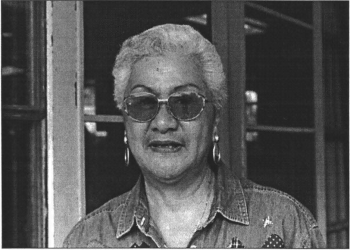Eloise Ahuna Pung

Tsunamis Remembered: Oral Histories of Survivors and Observers in Hawai‘i
Life history interviews with individuals who witnessed and survived tsunamis-particularly the 1946 and 1960 disasters on the Big Island of Hawai'i. Thirty individuals-mostly residents of Hilo and Laupahoehoe-recall their experiences before; during, and after the 1946 and 1960 tsunamis which were arguably the most destructive natural disasters in modem Hawaiian history.
The middle of three children born to Randolph Ahuna, Sr. and Adeline .Kame'ekua Ahuna, Eloise Ahuna Pung was born in Kukuiopa'e, South Kona, Hawai'i on December 16, 1933. Her paternal grandfather, Loo Ahuna, had a farm where he grew coffee and raised poultry and livestock. He also ran a charcoal-making business. As a child, Pung helped on the farm, doing various chores such as feeding the chickens, caring for the cattle and horses, cooking swill for the pigs and feeding them, pulling taro, and picking coffee. She attended 'Ala'e and Holualoa schools until the start of World War II. Her father was employed by the U.S. Engineering Department and moved the family to Hilo when Pung was a third-grader. After a few years living in rented homes, the family in 1945 was able to secure a lot and build a house on Hawaiian Home Lands in Keaukaha. She attended Hilo Union School, Waiakea Kai School and Hilo High School, graduating in 1952. After graduation, Pung attended Hawai'i Community College and later worked as a waitress at Paramount Grill and as a clerk at National Dollar Store. She worked at the Naniloa Hotel for seven years. In 1955, Pung worked for Hilo Iron Works. Since 1968, Pung has been employed at Industrial Steel Corporation. The oral history interview took place in Pung's home in Keaukaha, where she still lives with Albert Pung, whom she married in 1953. The couple raised two children and have two grandchildren.
Scope and Content Note
A woman recalls her family's farming lifestyle in Kona, where crops were exchanged for staples. She tells of moving to the town of Hilo, where her father built on Hawaiian Home Lands in Keaukaha. A witness to the 1946 tidal wave, she shares the experiences of her and her family. She also covers the effects of the 1960 tidal wave on her employer, Hilo Iron Works.
Program Note:
This interview is part of the Center for Oral History's project Tsunamis Remembered: Oral Histories of Survivors and Observers in Hawai‘i. Interviews from this project are available in the Center's ScholarSpace open access repository.
The Center for Oral History (COH), in the Department of Ethnic Studies at the University of Hawaiʻi at Mānoa, collects, documents, preserves and highlights the recollections of Native Hawaiians and the multi-ethnic people of Hawaiʻi. It produces oral histories and interpretive historical materials about lifeways, key historic events, social movements and Hawaiʻi’s role in the globalizing world, for the widest possible use.
Please Note: The oral histories in this collection are protected by copyright and have been created for educational, research and personal use as described by the Fair Use Doctrine in the U.S. Copyright law. Please reach out Voices@noaa.gov to let us know how these interviews are being used in your research, project, exhibit, etc. The Voices staff can help provide other useful resources related to your inquiry.
The NOAA mission is to understand and predict changes in climate, weather, oceans, and coasts, to share that knowledge and information with others, and to conserve and manage coastal and marine ecosystems and resources. The Voices Oral History Archives offers public access to a wide range of accounts, including historical materials that are products of their particular times, and may contain offensive language or negative stereotypes.
Voices Oral History Archives does not verify the accuracy of materials submitted to us. The opinions expressed in the interviews are those of the interviewee only. The interviews here have been made available to the public only after the interviewer has confirmed that they have obtained consent.
